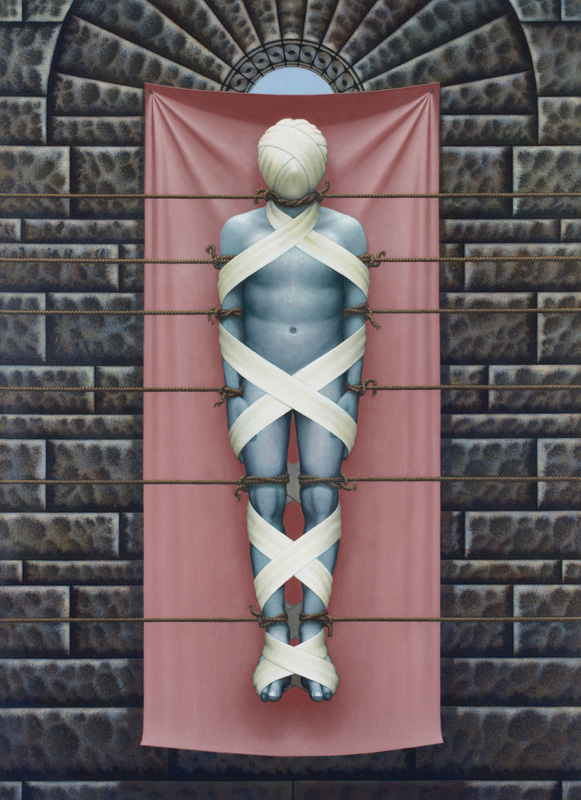
 |
| The Wall (Man) 1999, acrylic on canvas 66 x 48 in. |
The Wall (Man) |
The Wall (Man) follows my tradition of periodically creating minimal works instead of highly complex ones. In them I simplify their overall compositions as well as other aspects of the pictures. This typically allows the viewer to see the essence of the works in a single glance. The Wall (Man) includes five basic elements: the wall, a human figure, a red cloth, white bandages and ropes. Compositionally all the elements are placed parallel to the picture plane using layering, instead of perspective, to achieve spatial depth. The wall serves as the backdrop layer to the other elements and is a recurring motif in my work; this is my first painting to include a wall. Generally in my work the wall is a symbol for a manmade, earth-bound object that blocks humanity's ability to ascend to a spiritually transcendent space. In The Wall (Man) this transcendent space is represented by the empty blue space located through the small portal above the figure's head. Using the wall element also serves other functions in the painting. Its dark and highly textured rusticated stone surface is visually active and creates a sharp contrast with the light-toned, less detailed, and smooth textures of the other elements. In addition, the different heights and widths of the stones are spatially dynamic creating a visual representation of musical rhythm. This musical rhythm can also be seen in the variance of spacing between the ropes. And though there are six ropes instead of five, the ropes also suggest the lines of a musical staff. It is interesting to note that my impetus for using a wall element came from three disparate but influential sources – the neo-Romanesque architecture of H. H. Richardson, particularly the rusticated stonework he used for the exterior of his Allegheny County Courthouse and Prison in Pittsburg, PA; the dramatically lit walls in film noir, particularly those in the 1942 film Cat People by Jacques Tourneur; and the basic compositional elements in the Crucifixion Diptych by Rogier van der Weyden in the Philadelphia Museum of Art. All of the other elements in The Wall (Man) are in front of the wall. Primary among them is a lone figure that is held captive, suspended, and bound by the ropes. His head is shrouded and his body constrained by the bandages as he floats in front of a pristine cloth that is nailed to the stonewall. The deathly blue color of his body contrasts with both the red of the cloth and the white of the bandages while it also signals a symbolic color connection with the transcendent space beyond. The Wall (Man) is an evocative work. As such it gives rise to a myriad questions, including: Who is this man? Who created this dreadful tableau? Will he be suspended like this for eternity or be freed by an act of compassion? In the end does his shrouded condition and anonymity represent the fate of all of us? - Brian Mains, December 2020 |